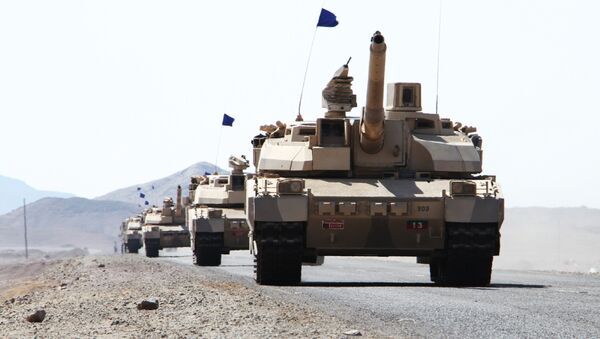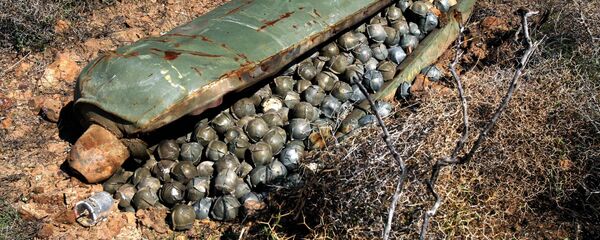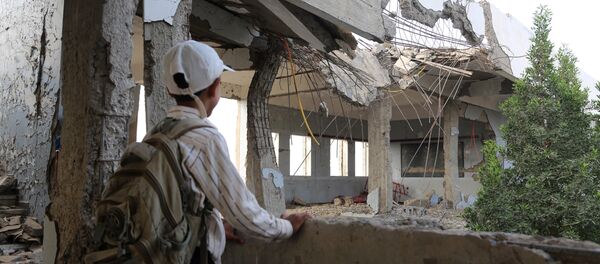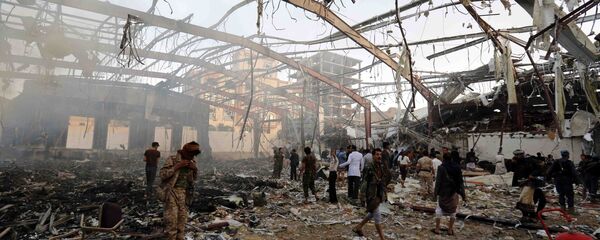Supporters of former Yemeni President Ali Abdullah Saleh who stepped down in 2011 at the height of the Arab Spring in exchange for immunity from political harassment and legal prosecution have sided with Houthi rebels, while army units, loyal to Hadi, and Sunni volunteers from local tribes opposed the rebels.
In February 2010, the Yemeni government and Shiite rebels signed a ceasefire agreement.
In mid-August 2014, Houthi-organized protests flared up in Yemen, and they escalated into clashes with security forces one month later.
After several unsuccessful attempts to launch dialogue with Hadi’s regime, in early 2015 the Houthis launched an all-out attack on major Yemeni cities, including the country’s capital of Sanaa and seized most of the country. Hadi was virtually ousted from power and fled from Sanaa to Aden where he set up his temporary residence. Later he was forced out of the country.
On March 22, 2015, the UN Security Council confirmed the legitimacy of Hadi's presidency and condemned the Houthis' actions. Later in the day, the Houthis established control over Yemen’s third largest city of Taiz and in early April, they entered Aden.
Saudi Arabia announced on March 23, 2015, that Persian Gulf states would act to defend the region from Houthi aggression. The initiative was supported by the United Arab Emirates, Kuwait, Bahrain, Qatar, Jordan, Morocco, Egypt, Sudan and Pakistan.
On March 26, 2015, the international coalition launched the Operation Decisive Storm in Yemen, carrying out airstrikes against the Houthis at Hadi's request. The coalition’s air force started bombing Sanaa, targeting Houthi-controlled air force, air defense installations, the international airport and residential areas. Coalition forces also attacked Houthi units, their camps, military equipment and the infrastructure in Yemen.
On April 21, 2015, the coalition sources announced the successful completion of the Operation Decisive Storm and the shift to the political-military Operation Renewal of Hope. It was announced that the Houthi threat to Saudi Arabia and its neighbors had been eliminated, that ballistic missiles seized by the rebels had been destroyed, and that the new campaign would aim to resume the political process, combat terrorism and counter Houthi military activity.
A fragile truce ended in mid-May, 2015, and the coalition launched new air strikes against Houthi positions.
In June, an attempt to launch indirect UN-mediated intra-Yemeni talks failed in Geneva.
By mid-July, forces, loyal to the legitimate authorities and supported by coalition land units, had retaken Aden and several strategically important southern areas. Hadi returned to Yemen and proclaimed Aden the country’s "temporary capital."
Apart from Saudi Arabia that leads the ten-country coalition, Qatar and the United Arab Emirates (UAE) contributed 1,000 soldiers each and Bahrain sent about 500 servicemen to ground operations.
In September 2015, media reported the deployment of 800 soldiers from Egypt. However, Cairo denied these claims. Nevertheless, Egypt was indeed involved in a naval blockade of Yemen. Other countries confined themselves to airstrikes and logistics support.
Faced with the coalition’s onslaught and losing the southern sector of the capital, the Houthis and Saleh agreed to begin talks under a plan approved by the United Nations calling for a complete ceasefire, the withdrawal of the rebel units from cities and the establishment of a national-unity government. Yemeni authorities refused to negotiate.
In late September, 2015, the Houthis carried out an successful attack in south of Sanaa and also attacked Saudi forces on the border with Saudi Arabia. In November, 400 Sudanese soldiers reinforced coalition forces operating in the Taiz province. According to some estimates, 10,000 service personnel were deployed on the ground.
On December 15, 2015, direct UN-mediated intra-Yemeni talks began in Geneva. At the same time, a seven-day truce was declared in Yemen, although fighting continued in the Al Jawf, Hajjah and Taiz governorates. The coalition advanced on Sanaa once again, with the Houthis retaliating by firing ballistic missiles against Saudi Arabia.
On December 20, 2015, UN Special Envoy for Yemen Ismail Ould Cheikh Ahmed announced an end to the talks. Participants had only been able to coordinate prisoner exchanges and the delivery of humanitarian relief aid.
In late December, the intra-Yemeni dialogue had virtually failed, with UN representatives noting that the coalition strikes against residential areas in Yemen violated international humanitarian law. The disastrous health situation deteriorated even more after the coalition air force destroyed two hospitals belonging to the Doctors Without Borders (Medecins Sans Frontieres, or MSF) humanitarian medical organization.
According to UN sources, almost 9,000 people were killed in Yemen over a period of one year, including over 3,000 civilians. Coalition forces were responsible for 50 percent of the fatalities.
Civilians make up to 95 percent of fatalities during attacks on densely populated areas.
Almost 2.5 million Yemenis fled their homes due to hostilities.
Contrary to a decision to continue the intra-Yemeni talks in mid-January 2016, the UN special envoy was only able to resume preliminary consultations in February, noting several days later that the parties were unable to come to an agreement on the terms of the dialogue’s new round.
In mid-March, 2016 it was suggested that the talks take place in Kuwait or Jordan, but no date was fixed.
In this context, forces, loyal to Hadi, retook Taiz. The head of state announced that the army still had to liberate 15 percent of the country’s territory and the coalition air force continued to attack rebel-held areas.
On March 17, a Saudi Arabian spokesperson announced a gradual drawdown of the coalition’s military operations in Yemen, noting that the coalition would continue to provide air support to Yemeni forces.
This statement came after coalition warplanes hit a marketplace three times in Mustaba District of Yemen’s Hajjah province. The air strikes killed 119 people and wounded 47 more, said a spokesperson for the healthcare directorate.
On March 21, 2016,Ould Cheikh Ahmed said that the parties to the Yemeni conflict had agreed to hold a new round of talks in Kuwait and had confirmed their readiness to set up a national unity government.
The media announced March 28 that the Houthis and Saudi Arabia had exchanged prisoners. A total of 100 Houthi rebels were swapped for nine Saudi Arabian prisoners.
A ceasefire agreement entered into force at midnight April 10, 2016. However, fighting continued in some parts of the country.
The United Nations brokered another round of peace talks in Kuwait that started on April 21. The talks almost failed several times because their participants accused each other of violating the ceasefire agreement.
During the talks, the government of Yemen and its Houthi opponents agreed to exchange prisoners in the run-up to the holy Muslim month of Ramadan.
On June 1, the media reported that Houthi rebels released 16 prisoners from the Abu Al-Abbas people’s militia unit seized in the Taiz province in central Yemen, in exchange for 19 of their supporters.
The parties to the Yemeni conflict also agreed to release all children who had been imprisoned.
On June 7, the media reported that the Saudi Arabian-led coalition had transferred 52 teenagers who had sided with Houthi rebels fighting government forces to the Government of Yemen.
On June 15, 2016, the UAE announced the withdrawal of the country’s servicemen from the Saudi Arabian-led Arab coalition’s operation against the Houthi rebels in Yemen.
On June 18, the parties to the Yemeni conflict exchanged prisoners near the city of Taiz in southwestern Yemen, under the mediation of local tribes. The parties exchanged about 200 people, namely, the Arab coalition released 118 people, while Houthi rebels freed another 76. According to the UAE media, this deal had nothing to do with the result of the intra-Yemeni peace talks in Kuwait.
Although intra-Yemeni talks continued for 70 days, the parties failed to reach any specific agreement, despite the UN special envoy’s attempts to persuade them to approve a road map stipulating the abolition of previously adopted decisions on running the country by Houthi rebels who had seized power. On June 29, 2016, Ould Cheikh Ahmed said that the intra-Yemeni talks had been put off until the end of the celebrations marking the end of Ramadan.
Talks between the Yemeni government delegation and that of the Houthi movement opposing it resumed in Kuwait July 16, 2016.
On July 31, 2016, Hadi approved the UN-backed draft agreement on resolving the Yemeni crisis. The agreement, proposed by Ould Cheikh Ahmed, urges Houthi rebels and forces, loyal to Saleh, to lay down their weapons. The document also calls for withdrawing rebel units from Sanaa and the cities of Taiz and Al Hudaydah and establishing a military committee responsible for surrendering weapons and withdrawing insurgents from the cities. A political dialogue was set to resume 45 days after signing the draft agreement by the parties.
Hadi instructed the government delegation at the talks in Kuwait to sign the draft agreement. In turn, the government delegation officially notified the UN special envoy that it would approve the document, provided that the rebels signed it by August 7.
This round of peace talks ended August 6, with the parties failing to reach any agreement and fighting involving the Saudi Arabian-led coalition soon resumed in the country.
On October 24, 2016, the media reported that Ould Cheikh Ahmed had officially submitted a plan backed by the United Nations for comprehensively resolving the national crisis to the Yemeni government delegation and that of the Houthi rebels.
The new UN plan stipulated a number of mutual concessions. The Houthis were expected to withdraw from the capital. In response, Vice President Ali Mohsen Ahmar was supposed to resign, and Hadi’s powers were to have been seriously curtailed.
The parties to the Yemeni conflict rejected this plan.
Despite his numerous efforts, Ould Cheikh Ahmed has so far failed to persuade the warring parties to sit down at the negotiating table after three abortive rounds of talks have not helped resolve the Yemeni armed conflict sputtering on for almost two years.
As of October 2016, almost 10,000 people had been killed in Yemen, according to UN estimates. The total of 21.2 million Yemeni citizens, which is 80 percent of the country’s population, are in need of urgent assistance, while another 14 million are malnourished, and seven million are on the verge of dying from starvation. There are over three million internally displaced people, as well as over 300,000 refugees.
Most Yemenis are unable to drink clean water and use the sanitary infrastructure. The national healthcare system has been virtually paralyzed due to the destruction of the appropriate infrastructure by air strikes and a shortage of medication and other preparations. Since 2015, 10,000 children have died due to a shortage of medical services. More and more Yemenis are affected by grave diseases such as cholera, acute forms of pneumonia and measles.
Never miss a story again — sign up to our Telegram channel and we'll keep you up to speed!





